Holiday in the Riviera dei Cedri
Everything you absolutely must not miss
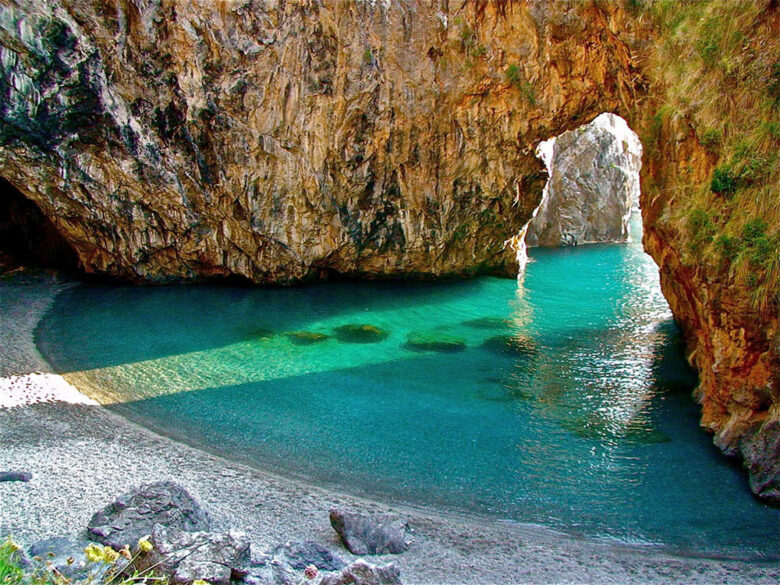
Distance by car
6 min
Walking distance
17 min
Arcomagno
The site of greatest naturalistic value is certainly Arcomagno. The path that leads to the Arcomagno beach is carved into the rock. The Arcomagno beach (Grotta d’u Saracinu) looks like a small paradise on earth, with a natural lagoon in the shape of a half moon that extends for about 25 metres.
The Arcomagno beach owes its name to the presence of a large rock arch that protects it from the sea and makes it unique in its kind. This small corner of Calabria was a docking point for the Saracens heading to Italy and is also called the Saraceno Cave. The cave is very humid due to a fresh water spring inside.
Passing the large arch, you can admire the Scoglio dello Scorzone. The enormous limestone rock extends for about 12 meters and is mostly composed of rock and vegetation only in the most central part. According to popular tradition, the rock owes its name to the snake snake, the harmless chicken coop viper, which in the local Calabrian dialect is referred to as u scurzun.

Distance by car
17 min
Walking distance
17 min
Arcomagno
The site of greatest naturalistic value is certainly Arcomagno. The path that leads to the Arcomagno beach is carved into the rock. The Arcomagno beach (Grotta d’u Saracinu) looks like a small paradise on earth, with a natural lagoon in the shape of a half moon that extends for about 25 metres.
The Arcomagno beach owes its name to the presence of a large rock arch that protects it from the sea and makes it unique in its kind. This small corner of Calabria was a docking point for the Saracens heading to Italy and is also called the Saraceno Cave. The cave is very humid due to a fresh water spring inside.
Passing the large arch, you can admire the Scoglio dello Scorzone. The enormous limestone rock extends for about 12 meters and is mostly composed of rock and vegetation only in the most central part. According to popular tradition, the rock owes its name to the snake snake, the harmless chicken coop viper, which in the local Calabrian dialect is referred to as u scurzun.
Dino Island
Dino Island is located off the coast of Calabria near Praia a Mare. This small island, the larger of the two belonging to Calabria, is famous for its incredible natural beauty and the crystal clear waters that surround it. The island is dominated by lush vegetation and features imposing limestone cliffs that rise directly from the sea.
One of the main attractions of Dino Island are its sea caves, accessible only by sea. Among these, the best known is the Blue Grotto, which owes its name to the way in which sunlight, filtering through the water, creates a light blue luminous effect. Other notable caves include the Grotta del Leone and the Frontone Grotto, each with their own unique features.
Visitors can explore the island via boat trips that depart regularly from the nearby coast, offering a unique opportunity to swim in these transparent waters and snorkel. Dino Island is not only a paradise for nature and adventure lovers but also represents an important site of geological and biological interest, making it an unmissable destination for those visiting Calabria.
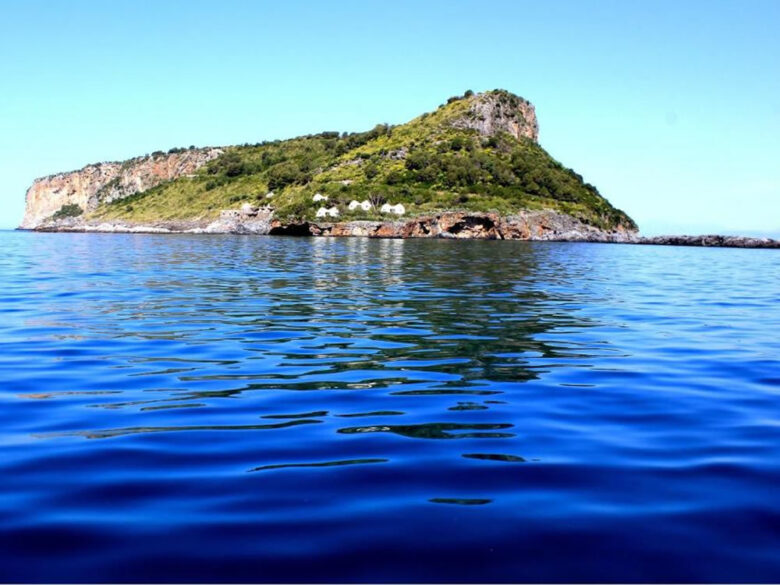
Distance by car
13 min

Distance by car
13 min
Dino Island
Dino Island is located off the coast of Calabria near Praia a Mare. This small island, the larger of the two belonging to Calabria, is famous for its incredible natural beauty and the crystal clear waters that surround it. The island is dominated by lush vegetation and features imposing limestone cliffs that rise directly from the sea.
One of the main attractions of Dino Island are its sea caves, accessible only by sea. Among these, the best known is the Blue Grotto, which owes its name to the way in which sunlight, filtering through the water, creates a light blue luminous effect. Other notable caves include the Grotta del Leone and the Frontone Grotto, each with their own unique features.
Visitors can explore the island via boat trips that depart regularly from the nearby coast, offering a unique opportunity to swim in these transparent waters and snorkel. Dino Island is not only a paradise for nature and adventure lovers but also represents an important site of geological and biological interest, making it an unmissable destination for those visiting Calabria.
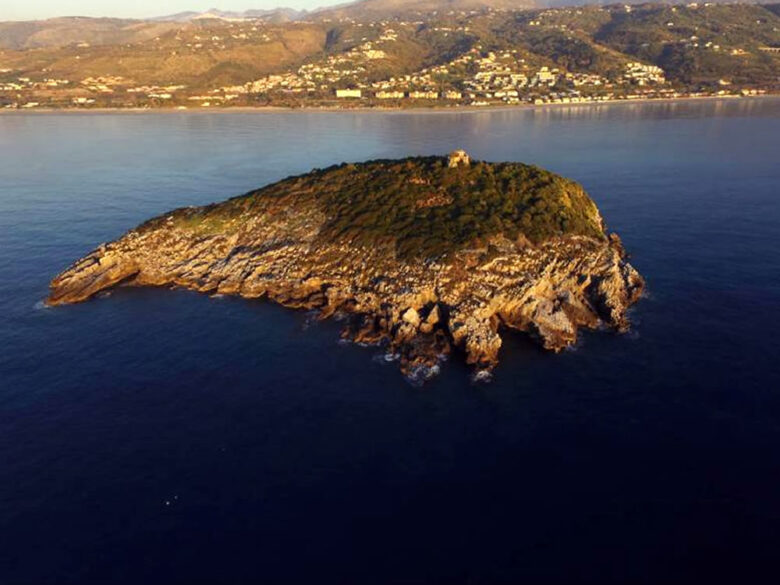
Distance by car
23 min
Cirella Island
The Cirella Island is an enchanting glimpse of the Calabrian coast, located in front of the ancient village of the same name, not far from Diamante. This small island stands out for its tranquil environment and the lush Mediterranean vegetation that covers it, offering an ideal habitat for several species of birds and endemic flora.
Characterized by rocks and cliffs, the Cirella Island is renowned for its clear waters and rich marine life, which make it a perfect place for snorkelling and diving enthusiasts. Its transparent waters allow you to easily observe the seabed, populated by a wide variety of fish and marine organisms.
Despite its small size, the Island of Cirella is full of history. There are the remains of an ancient watchtower, which testifies to the strategic past of the island as a defense point against pirate attacks. This place not only fascinates with its natural beauty, but also with the mystery that surrounds its ancient history.
Guided boat tours are available from the nearby coast, allowing visitors to explore the island and enjoy its stunning views and tranquil beaches. The Cirella Island represents an unmissable stop for those looking for a day of relaxation and adventure, immersed in nature and history along the splendid coasts of Calabria.

Distance by car
23 min
Cirella Island
The Cirella Island is an enchanting glimpse of the Calabrian coast, located in front of the ancient village of the same name, not far from Diamante. This small island stands out for its tranquil environment and the lush Mediterranean vegetation that covers it, offering an ideal habitat for several species of birds and endemic flora.
Characterized by rocks and cliffs, the Cirella Island is renowned for its clear waters and rich marine life, which make it a perfect place for snorkelling and diving enthusiasts. Its transparent waters allow you to easily observe the seabed, populated by a wide variety of fish and marine organisms.
Despite its small size, the Island of Cirella is full of history. There are the remains of an ancient watchtower, which testifies to the strategic past of the island as a defense point against pirate attacks. This place not only fascinates with its natural beauty, but also with the mystery that surrounds its ancient history.
Guided boat tours are available from the nearby coast, allowing visitors to explore the island and enjoy its stunning views and tranquil beaches. The Cirella Island represents an unmissable stop for those looking for a day of relaxation and adventure, immersed in nature and history along the splendid coasts of Calabria.
Diamante Murals
The Diamante Murals are one of the most colorful and artistic attractions in Calabria, transforming the picturesque village of Diamante into a true open-air art gallery.
This artistic phenomenon began in the 1980s when, in an attempt to revitalize the town and celebrate local culture, artists from all over the world were invited to paint the walls of the houses, facades and alleys of the historic center.
Today, Diamante boasts over 300 murals adorning the streets of the village, each telling different stories through vibrant images and often accompanied by poems and written reflections. These artworks range from scenes of everyday life, portraits of people, depictions of local traditions to social and political commentary, offering an eclectic and deeply personal insight into the community.
The visit to the Diamante Murals is a unique experience that allows visitors to immerse themselves in local culture and history while exploring the narrow streets and squares of one of the most fascinating villages in the region. Each year, new murals are added during the annual festival, keeping the tradition alive and continually enriching the viewing experience.
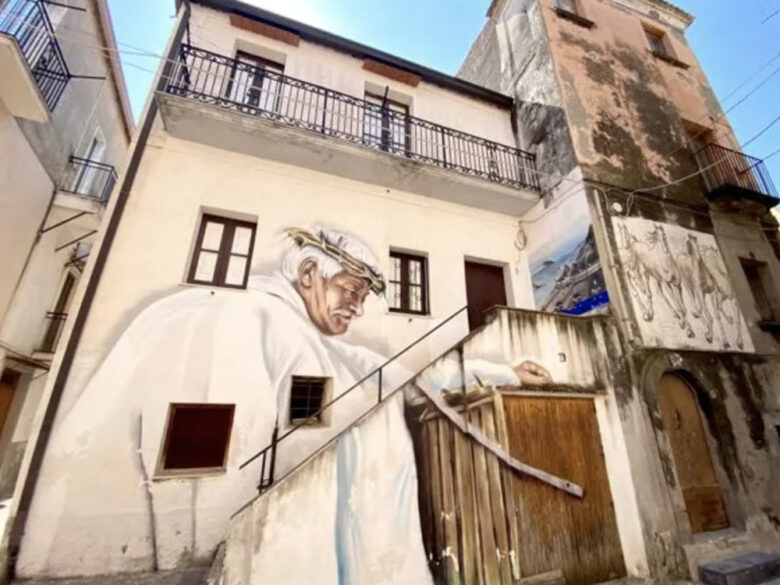
Distance by car
26 min

Distance by car
26 min
Diamante Murals
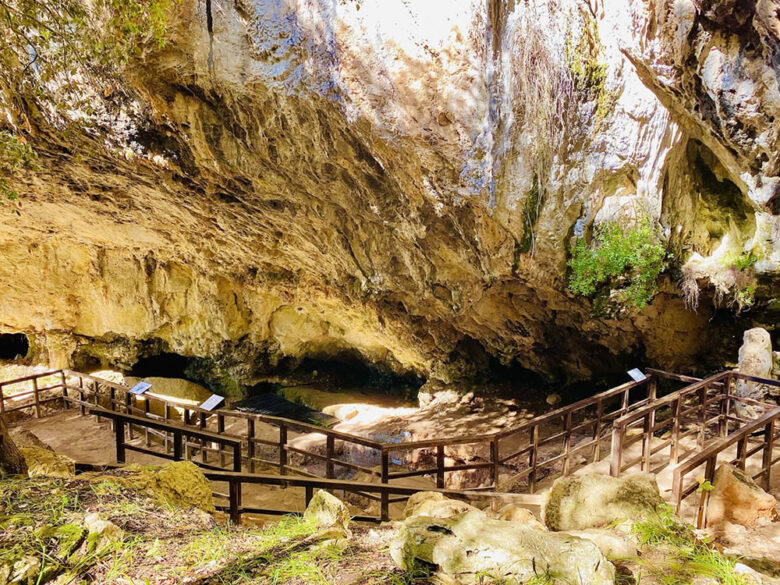
Distance by car
50 min
Romito Cave

Distance by car
50 min
Romito Cave
The Romito Cave of Papasidero is an archaeological site of exceptional historical and cultural value, located in the heart of the Pollino National Park, in Calabria. This prehistoric cave is famous for its rock carvings and archaeological finds that testify to human presence since the Upper Paleolithic, about 12,000 years ago.
Inside the cave, archaeologists discovered important finds, including stone tools, remains of bonfires and, above all, rock engravings among the oldest in Italy. The best-known piece is the “Bos Primigenius”, an engraving depicting a wild bull, executed with extraordinary skill and considered one of the most significant artistic expressions of the prehistoric period in Europe.
The visit to the Romito Cave offers tourists not only the opportunity to admire these extraordinary archaeological artefacts, but also to immerse themselves in the atmosphere of a distant time, exploring an almost unaltered natural environment. The path to the cave, immersed in the lush vegetation of the Pollino Park, adds a further level of wonder and adventure to the experience.
Christ of Maratea
The Christ of Maratea, also known as the Christ the Redeemer of Maratea, is one of the most imposing and symbolic statues in Italy, located on the top of Monte San Biagio, majestically dominating the panorama of the splendid coast of Maratea, in Basilicata. This statue, approximately 22 meters high and with a bracelet span of 19 metres, is visible from numerous points along the coast and represents a spiritual and tourist reference point in the region.
Made of Carrara marble by the Florentine artist Bruno Innocenti, the statue was inaugurated in 1965 and is clearly inspired by the more famous Christ the Redeemer of Rio de Janeiro, albeit with its own distinctive characteristics and unique expression. In addition to its artistic grandeur, the Christ of Maratea also attracts visitors for its religious meaning, being a symbol of peace and blessing for the faithful who come here from all over the world.
The surrounding area offers a sanctuary, an ancient convent and the ruins of a medieval church dedicated to San Biagio, patron saint of Maratea, enriching the experience with a profound historical and cultural sense. The site also offers one of the most spectacular panoramic points in the region, with views spanning the Gulf of Policastro and the surrounding mountains, making a visit to the Christ of Maratea an unforgettable experience for both its scenic beauty and spiritual depth.
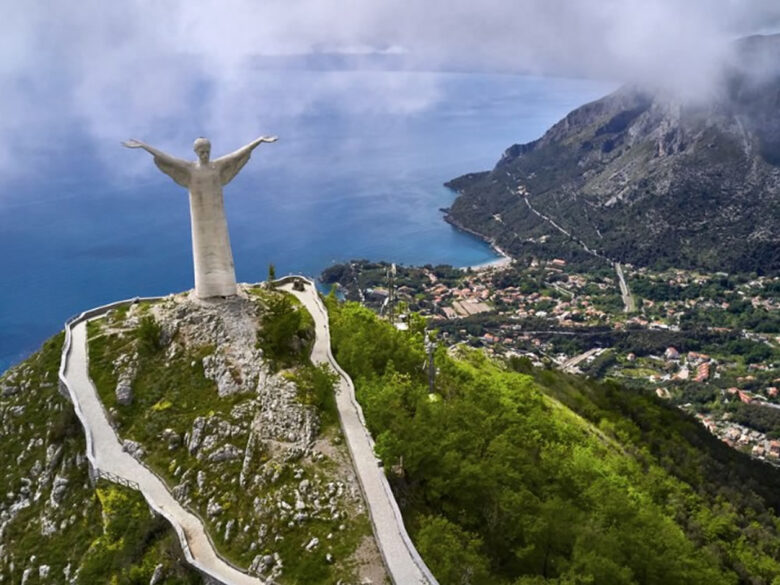
Distance by car
45 min

Distance by car
45 min
Christ of Maratea
The Christ of Maratea, also known as the Christ the Redeemer of Maratea, is one of the most imposing and symbolic statues in Italy, located on the top of Monte San Biagio, majestically dominating the panorama of the splendid coast of Maratea, in Basilicata. This statue, approximately 22 meters high and with a bracelet span of 19 metres, is visible from numerous points along the coast and represents a spiritual and tourist reference point in the region.
Made of Carrara marble by the Florentine artist Bruno Innocenti, the statue was inaugurated in 1965 and is clearly inspired by the more famous Christ the Redeemer of Rio de Janeiro, albeit with its own distinctive characteristics and unique expression. In addition to its artistic grandeur, the Christ of Maratea also attracts visitors for its religious meaning, being a symbol of peace and blessing for the faithful who come here from all over the world.
The surrounding area offers a sanctuary, an ancient convent and the ruins of a medieval church dedicated to San Biagio, patron saint of Maratea, enriching the experience with a profound historical and cultural sense. The site also offers one of the most spectacular panoramic points in the region, with views spanning the Gulf of Policastro and the surrounding mountains, making a visit to the Christ of Maratea an unforgettable experience for both its scenic beauty and spiritual depth.


